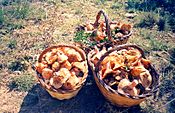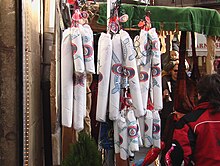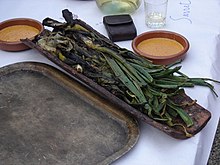Andorran cuisine
The Iberian country of Andorra may be tiny, but it has plenty of attractive lures for visitors: dramatic, craggy mountains; lush forests and meadows; pristine lakes; wintery slopes ideal for snow sports. Not least of all, Andorra is home to an exciting range of foods and flavors, with a cuisine heavily influenced by the country’s unique location in the Pyrenees, sandwiched between Spain and France.
The effect on Andorran food is palpable: The region carries strong infusions of neighboring cuisines, especially Catalan and Provençal, and produces some truly exceptional food. The natural resources of the area—such as plentiful freshwater fish, Mediterranean produce, and abundant livestock (cow, goat, sheep, pig)—offer a smorgasbord of interesting flavors, which the Andorran people have combined into impressive recipes, both traditional and modern.
Basic ingredients
Andorran cuisine relies heavily on ingredients popular along the Mediterranean coast, including fresh vegetables (especially tomato, garlic, eggplant (aubergine), capsicum, and artichoke), wheat products (bread, pasta), Arbequina olive oils, wines, legumes (beans, chickpeas), mushrooms (particularly wild mushrooms), nuts (pine nuts, hazelnuts and almonds), all sorts of pork preparations (sausage from Vic, ham), sheep and goats' cheese, poultry, lamb, and many types of fish like sardine, anchovy, tuna, and cod.
Traditional Andorran cuisine is quite diverse, ranging from pork-intensive dishes cooked in the inland part of the region (Catalonia is one of the main producers of swine products in Spain) to fish-based recipes along the coast. These meat and seafood elements are frequently fused together in the Catalan version of surf and turf, known as mar i muntanya. Examples include chicken with lobster (pollastre amb llagosta), chicken with crayfish (pollastre amb escarmalans), and rice with meat and seafood (arròs mar i muntanya).
The cuisine includes many preparations that mix sweet and savoury and stews with sauces based upon botifarra (pork sausage) and the characteristic picada (ground almonds, hazelnuts, pine nuts, etc. sometimes with garlic, herbs, biscuits).
Savoury dishes
- Catalan-style cod (with raisins and pine nuts)
- Escalivada (various grilled vegetables)
- Escudella (a stew, it may be served as soup with pasta and minced meats and vegetables, or as the soup first and then the rest)
- Fricandó
- Ollada (meat and vegetable stew)
- Esqueixada (salted cod salad with tomato and onion)
- Mongetes amb botifarra (beans and pork sausage)
- Pa amb tomàquet (bread smeared with tomato and oil, and sometimes garlic)
- Tonyina en escabetx (tuna escabeche)
- Suquet (a seafood casserole)
- Savoury coca
- Mar i muntanya ("Sea and Mountain") dishes, which combine meat and seafood
- Embotits, a generic name for different kinds of cured pork meat, including fuet (a characteristic type of dried sausage) and salchichón or llonganissa (salami).
- Calçot (specially cultivated onion, grilled and served as a "Calçotada")
- Caragols a la llauna (cooked snails)
- Sonsos (Gymnammodytes cicerelus, also known as Mediterranean sand eel, sonso in Catalan, and barrinaire or enfú in Menorca, is a fish in the family Ammodytidae. It is the only species of this family in the Mediterranean Sea.)
Sauces and condiments
- Allioli, a thick sauce made of garlic and olive oil, used with grilled meats or vegetables, and some dishes. Allioli means garlic (all) and (i) oil (oli) in Catalan.
- Samfaina, also called tomacat or pebrots amb tomàquet. It is a variety of Occitan ratatouille or Spanish pisto.
- Romesco or Salvitxada (made from almonds, hazelnuts, garlic, bread, vinegar, tomatoes, olive oil and dried red peppers) from Valls.
- Xató, a variety of Salvitxada without tomatoes.
Sweets and desserts
- Crema catalana, the famous yellow cream made with egg yolk, milk and sugar, whose denseness is between a crème pâtissière or natillas and a flan; used to stuff a great amount of pastries, or to make simple desserts with, for example, fruit, and that is also eaten in a small flat pottery plate, after covering the cream with white crystal sugar and burning it, in order to create a layer of solid sugar that has to be broken with a small spoon before reaching the cream.
- Mató de Pedralbes or mató de monja is another kind of Catalan cream, similar to crema catalana, originating in Barcelona.
- Menjablanc or menjar blanc, typical of Reus but eaten all over Catalonia, is a kind of white cream made with almonds, from which a sort of milk is first obtained, followed by a cream to be eaten with a small spoon.
- Peres de Lleida is a typical dessert originated in Lleida composed of peeled pears cooked in a kind of lighter crema catalana and served cold, covered by meringue and decorated with cherries.
- Xuixos are fried pastries created in Girona and stuffed with crema catalana.
- Mel i mató, a dessert of mató cheese with honey
- Pastissets, or casquetes, de cabell d'àngel are sweet half-circle shaped pastries stuffed with cabell d'àngel(a sort of marrow jam) and covered with white crystal sugar which are eaten at coffee time.
- Carquinyolis are little crunchy almond biscuits often eaten at coffee time.
- Catànies are Catalan marcona almonds covered with white chocolate and powdered black chocolate to be eaten with coffee.
- Pets de monja are small nipple-shaped and -sized biscuits also eaten at coffee time. At first they were called pits de monja (nuns' nipples) but time has changed their name to the current pets de monja(nuns' farts).
- Sweet coques were at first eaten only on holidays. Catalans have at least one type of traditional coca for each holiday and feast day of the year.
- Orelletes are thin fried pastries covered with sugar and eaten during Carnival. They also exist in nearby regions in Spain or France.
- Sweet bunyols as bunyols de vent, bunyols stuffed with crema catalana or bunyols de l'Empordà are typically done and eaten on Wednesdays and Fridays during Lent.
- Mona de Pasqua is a pastry richly covered with almonds, yolk jam, chocolate eggs (or, currently, large chocolate sculptures) and coloured decoration that the godfather and godmother give as a present every year to their godchildren on Easter (Pasqua). It is an ancient pre-Christian tradition which marked the passage from childhood to the adult world. At first, it has one egg for each year of the children's age, and continuing to add one egg each year until twelve, as at thirteen they are no longer considered children.
- Panellets are small pastries made of pine nuts, almonds and sugar with different shapes and flavors, eaten during la Castanyada, which Catalans celebrate on 1 November instead of Halloween. Their origin is Jewish, before the Middle Ages, but the tradition of castanyada is much older.
- Tortell, also called torta or roscó in Northern and Southern dialects. It is round, it can be made of puff pastry or a mixture similar to lionesasand palos, and stuffed with trufa (a mixture of cacao, chocolate and cream) or with crema catalana. It is typically bought and eaten after Sunday's lunch, in family or with friends. A common alternative is called the braç de gitano (Gypsy's arm), that in Catalonia is always covered with yolk jam.
- A specific tortell is in fact a special coca that Catalans only eat on the Day of the Three Kings (6 January) which is called tortell de reis (or galeta de reis in Northern Catalonia) a typical ring-shaped pastry stuffed with marzipan or Catalan cream (crema catalana) and topped with glazed fruit and nuts.
- Torró, a Christmas sweet made with almonds with DAO of Agramunt (Lleida).
- Neules are also eaten on Christmas in Catalonia. They are dipped in cava (Catalan champagne). They have the same origin as waffles and Belgian Goffres.








Comments
Post a Comment